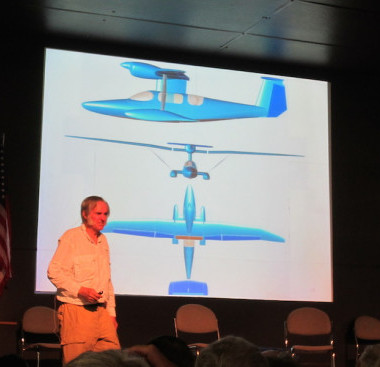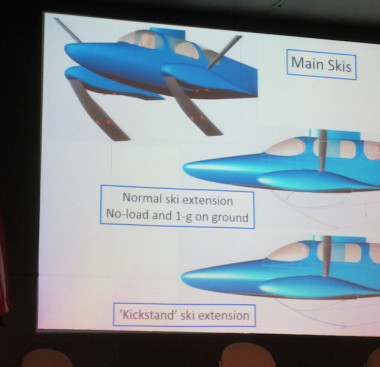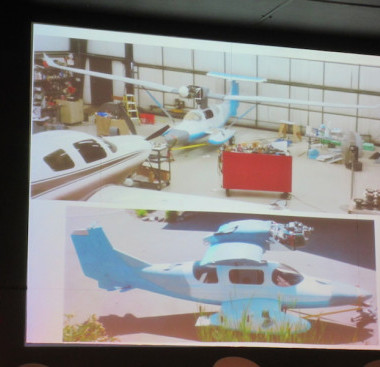Burt Rutan’s SkiGull Flying Boat
Burt Rutan is probably the most famous aircraft designer in the world, so it’s always interesting to see what he’s up to. These days, perhaps inspired by his new retirement digs in Lake Coeur d’Alene, Idaho, he’s building a trimaran in his garage. A flying trimaran named the SkiGull. The amphibious airplane is a “dream plane for Rutan and his wife, Tonya, a newly-minted seaplane pilot. Together, they plan to tour the world and land virtually anywhere they desire, not just at airports.”
The most unique design feature of the amphibian is a pair of extendable water skis that are reminiscent of the 1950s era Convair Sea Dart. The twin skis include small 4-inch diameter wheels and hydraulic shock absorbers. Rutan said that seaplanes have long needed shock absorbers to cushion the ride on rough water.
In typical Rutan style, the amphibian does not follow any of the conventional approaches. It is unlike a typical floatplane, nor is it a classic flying boat, but it has elements of both. You can see his devious drag cheating mind at work here. Floatplanes are based off of a standard airplane, but must carry around floats that also carry a large surface area penalty. The floats are useful during takeoff and landing, but otherwise they are useless drag. On the other hand, a flying boat style airplane dispenses with the floats, and incorporates the fuselage into the boat, which is a more efficient use of materials and surface area, but is also dealt a big drag penalty because the “boat” shaped hull is not very friendly to air blowing by at over 100 knots.
Rutan’s design has twin floats, but we note that they are relatively small, and they aren’t aerodynamically crude stepped hydroplane shapes either. They are very nice Rutan teardrops. The floats don’t have near enough buoyancy to support the craft, so the central fuselage is also “swimming” - like a trimaran. This hull is watertight, but it is far more airplane than boat in shape, and should be far more aerodynamic. The reason it all works is because Rutan is not relying on his air-friendly but water-draggy shapes to get the boat up to takeoff speed. For that, he extends the water skis.
“For water takeoffs, the two skis stay retracted until the plane accelerates to 15-22 knots, when the skis are extended, allowing it rise and absorb shocks for the remainder of the ski-borne takeoff run,” he explained.
To help the plane get off the water easily, a large 44% chord Fowler flap is located at the center of the wing, directly in the airflow of the propeller.
“It normally lands with skis extended,” added Rutan. “However, it can land on smooth water or grass with skis retracted.”
I’ll bet yacht design could learn a thing or three from airplane designers. Read full article at General Aviation News.





Hi Michael,
Brother Burt…always on the cutting edge. Always thinking way out of the box. The Dick Newick of planes.
I was curious about how he was going to build,” a trimaran in his garage”. And then I saw his “garage”! Well okay then!
Thanks for posting and Cheers from Maui,
claudio